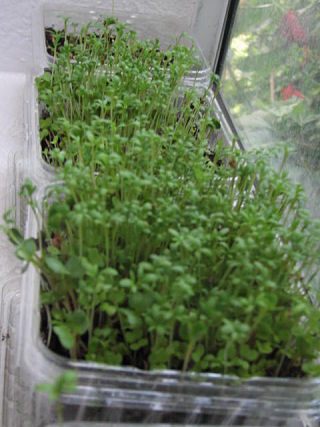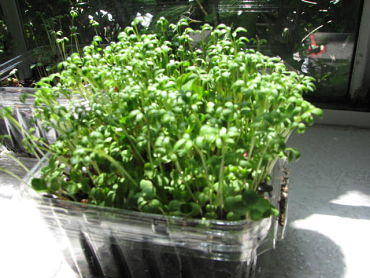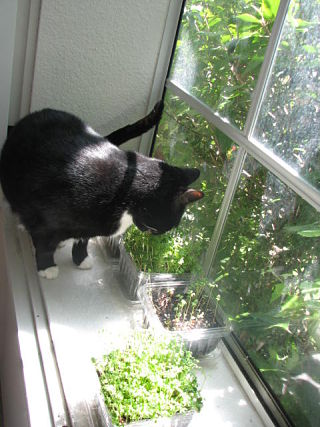An Indoor Microgreen Garden Can Be Inexpensive and Fun
Microgreens are the perfect crop to bring nature into your home – and with tasty results. Microgreens are very young vegetable and herb plants, usually an inch or two high and with one or two sets of leaves. You usually have to wait only a week or two from the time the seed first starts to grow until the time your crop is ready to eat.
You can raise these nutritious, pretty young plants to garnish almost any food. For example, sprinkle some on soups, salads, cooked grains, sandwiches, wraps, and beans. Microgreens add elegance and color as well as nutrition, texture, and flavor to even simple dishes. Many restaurants deploy microgreens to great advantage, but you can have more fun growing and using them yourself.
As a city dweller with zero outdoor space for a garden, I was longing to grow some of my own food when Vegetarian Voice published a how-to article by Mark Mathew Braunstein. The author outlines a method to produce microgreens with simple, inexpensive supplies and minimal effort. (He also has his method online in plenty of detail to duplicate it yourself. Just follow the link.)
Basically, you need the plastic clamshell containers that small fruits and veggies (such as strawberries, blueberries, and cherry tomatoes) come packaged in. These are free, assuming you are going to buy the food anyway. You also need potting soil, a spray bottle, seeds, and probably a trowel. Twenty dollars will get you started and keep you going a long time.
I was thrilled when my first batch of seeds pushed tiny plants out of the soil after only a couple days of watering. This miracle of birth connected me to green growing beings that are the foundation for life on earth. I felt as if nature were now dwelling in my urban townhouse. I looked at the seedlings and saw a forest, especially as they started to densely fill their container. Stress melted

I planted seven containers in all, kept on one windowsill. This is day five for some of the seedlings.
whenever I looked at or worked with the plants. Horticulture therapy works even on such a small scale.
I faced two unexpected challenges in following the Vegetarian Voice directions. First, finding vegan potting soil was difficult. The organic brands in local stores all had feather meal or some other animal ingredients that made me not want to buy them. The nonorganic soils appeared vegan, but also infused with chemicals.
A Facebook posting with a cry for help solved the problem. A friend generously gave me five gallons of homemade, organic vegan potting soil, and some organic vegetable and herb seeds to boot! Another friend messaged me that I could perhaps get soil from a mushroom farm about an hour from my house. This soil would be depleted of nitrogen, but easily revived with some compost or fertilizer.
The second big challenge is defending the seedlings from my cat Nikki. Like most cats, she loves to nibble on greens and then delightfully throws up after. She is really fast and aggressive about getting what she wants. So my little home farm is confined to one window with wooden shutters to protect the plants from feline grazing. When I take them out to water, I have to be ever alert and put a plastic dome over the plants to slow Nikki down (she always gets a few leaves, anyway).
Of course, Nikki is not the only one to enjoy the seedlings. I’ve loved the harvest on wraps, sandwiches, and stir fries several times now. The seven strawberry boxes I planted are producing quite a bounty. The spicy microgreen mix, mild microgreen mix, lettuce, and spinach taste pretty similar when an inch or two high – a tiny bit spicy and very different than the mature plants.
Do microgreens have a nutritional advantage over fully grown vegetables and herbs? No one can answer this for sure. On a whole foods, plant-based diet, luckily you don’t have to worry about this question at all. As The Perfect Formula Diet describes, you will be eating whole foods, not dissecting them into individual nutrients. The microgreens are one more player on your whole foods, plant-based superstar team.
So enjoy the pleasing appearance and interesting taste of your microgreens, and know you are growing health and satisfaction right along with the seedlings.
Intrigued? Now you can use our Whole Foods Blog Finder to target informative, fun postings on plant-based nutrition. Quick information at no cost!
Blog posting by Janice Stanger, Ph.D. Janice authored The Perfect Formula Diet: How to Lose Weight and Get Healthy Now With Six Kinds of Whole Foods. This easy-to-follow eating plan is built on sustainable food choices that can prevent, or even reverse, most chronic disease.
Tags: getting healthy, horticulture therapy, indoor gardening, Janice Stanger, Mark Mathew Braunstein, microgreens, Plant-based nutrition, whole foods







Do you pull them out at the root or snip them off with scissors?
You snip off microgreens with scissors. You eat the leaves and stem, not the root. I’ve been puzzling about reusing the soil, but decided to dump it outside where the association has miscellaneous shrubs as it is depleted of nutrients and intertwined with roots.
Have been bowled over by Fionna Hill’s book, “Microgreens” which gives many suppliers’ contact info and many, many pics of these supergreens in everything from bonsai bowls to flowerpots. It spurred me on to this inside gardening, since my outside is very, very hot…